Psychology Solved Assignment
VerifiedAdded on 2019/10/01
|18
|4473
|196
Homework Assignment
AI Summary
This document presents a comprehensive set of solved assignments for a psychology course. It's structured by modules, each containing several activities and questions with detailed answers. The solutions cover various topics within psychology, including pedagogy, cognitive development theories (Piaget, Montessori, Gardner), Bronfenbrenner's ecological systems theory, toxic stress, attachment theory, behaviour management, and different early childhood education frameworks (Te Whariki, EYLF, Swedish framework). The answers demonstrate a strong understanding of the subject matter and provide insightful explanations. The document also includes a table of contents and a list of references.

1
PSYCHOLOGY
PSYCHOLOGY
Paraphrase This Document
Need a fresh take? Get an instant paraphrase of this document with our AI Paraphraser
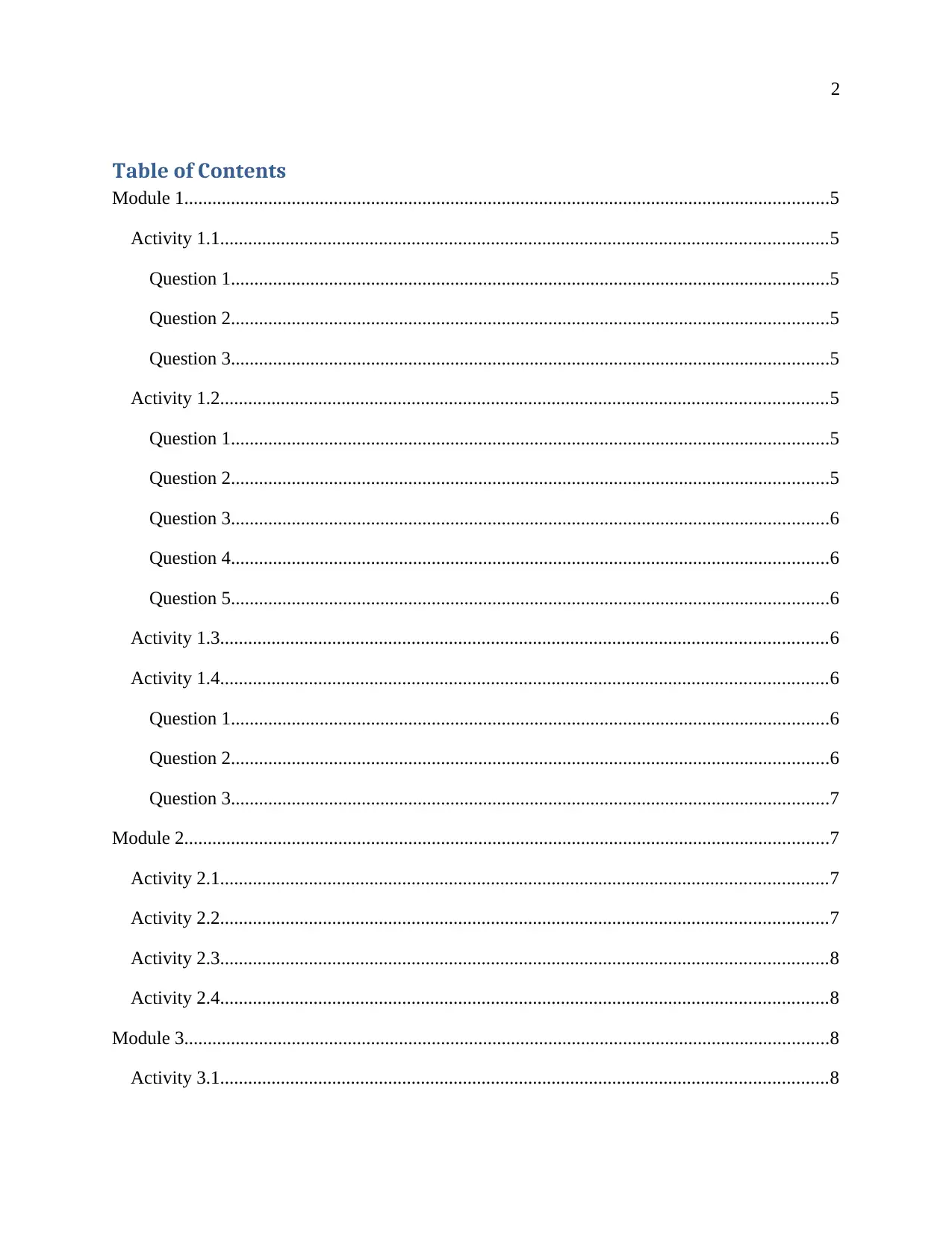
2
Table of Contents
Module 1..........................................................................................................................................5
Activity 1.1..................................................................................................................................5
Question 1................................................................................................................................5
Question 2................................................................................................................................5
Question 3................................................................................................................................5
Activity 1.2..................................................................................................................................5
Question 1................................................................................................................................5
Question 2................................................................................................................................5
Question 3................................................................................................................................6
Question 4................................................................................................................................6
Question 5................................................................................................................................6
Activity 1.3..................................................................................................................................6
Activity 1.4..................................................................................................................................6
Question 1................................................................................................................................6
Question 2................................................................................................................................6
Question 3................................................................................................................................7
Module 2..........................................................................................................................................7
Activity 2.1..................................................................................................................................7
Activity 2.2..................................................................................................................................7
Activity 2.3..................................................................................................................................8
Activity 2.4..................................................................................................................................8
Module 3..........................................................................................................................................8
Activity 3.1..................................................................................................................................8
Table of Contents
Module 1..........................................................................................................................................5
Activity 1.1..................................................................................................................................5
Question 1................................................................................................................................5
Question 2................................................................................................................................5
Question 3................................................................................................................................5
Activity 1.2..................................................................................................................................5
Question 1................................................................................................................................5
Question 2................................................................................................................................5
Question 3................................................................................................................................6
Question 4................................................................................................................................6
Question 5................................................................................................................................6
Activity 1.3..................................................................................................................................6
Activity 1.4..................................................................................................................................6
Question 1................................................................................................................................6
Question 2................................................................................................................................6
Question 3................................................................................................................................7
Module 2..........................................................................................................................................7
Activity 2.1..................................................................................................................................7
Activity 2.2..................................................................................................................................7
Activity 2.3..................................................................................................................................8
Activity 2.4..................................................................................................................................8
Module 3..........................................................................................................................................8
Activity 3.1..................................................................................................................................8
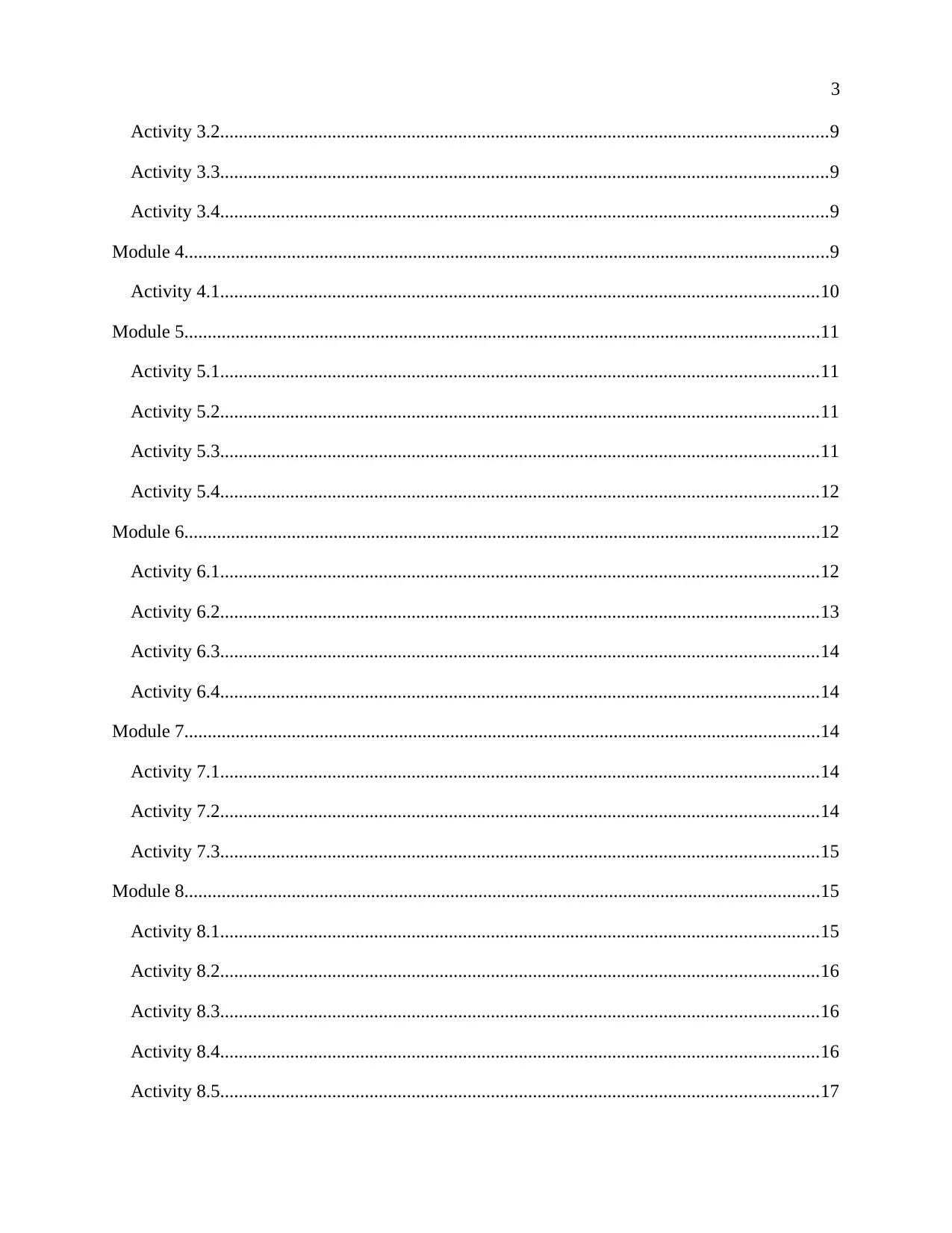
3
Activity 3.2..................................................................................................................................9
Activity 3.3..................................................................................................................................9
Activity 3.4..................................................................................................................................9
Module 4..........................................................................................................................................9
Activity 4.1................................................................................................................................10
Module 5........................................................................................................................................11
Activity 5.1................................................................................................................................11
Activity 5.2................................................................................................................................11
Activity 5.3................................................................................................................................11
Activity 5.4................................................................................................................................12
Module 6........................................................................................................................................12
Activity 6.1................................................................................................................................12
Activity 6.2................................................................................................................................13
Activity 6.3................................................................................................................................14
Activity 6.4................................................................................................................................14
Module 7........................................................................................................................................14
Activity 7.1................................................................................................................................14
Activity 7.2................................................................................................................................14
Activity 7.3................................................................................................................................15
Module 8........................................................................................................................................15
Activity 8.1................................................................................................................................15
Activity 8.2................................................................................................................................16
Activity 8.3................................................................................................................................16
Activity 8.4................................................................................................................................16
Activity 8.5................................................................................................................................17
Activity 3.2..................................................................................................................................9
Activity 3.3..................................................................................................................................9
Activity 3.4..................................................................................................................................9
Module 4..........................................................................................................................................9
Activity 4.1................................................................................................................................10
Module 5........................................................................................................................................11
Activity 5.1................................................................................................................................11
Activity 5.2................................................................................................................................11
Activity 5.3................................................................................................................................11
Activity 5.4................................................................................................................................12
Module 6........................................................................................................................................12
Activity 6.1................................................................................................................................12
Activity 6.2................................................................................................................................13
Activity 6.3................................................................................................................................14
Activity 6.4................................................................................................................................14
Module 7........................................................................................................................................14
Activity 7.1................................................................................................................................14
Activity 7.2................................................................................................................................14
Activity 7.3................................................................................................................................15
Module 8........................................................................................................................................15
Activity 8.1................................................................................................................................15
Activity 8.2................................................................................................................................16
Activity 8.3................................................................................................................................16
Activity 8.4................................................................................................................................16
Activity 8.5................................................................................................................................17
⊘ This is a preview!⊘
Do you want full access?
Subscribe today to unlock all pages.

Trusted by 1+ million students worldwide

4
References......................................................................................................................................18
References......................................................................................................................................18
Paraphrase This Document
Need a fresh take? Get an instant paraphrase of this document with our AI Paraphraser
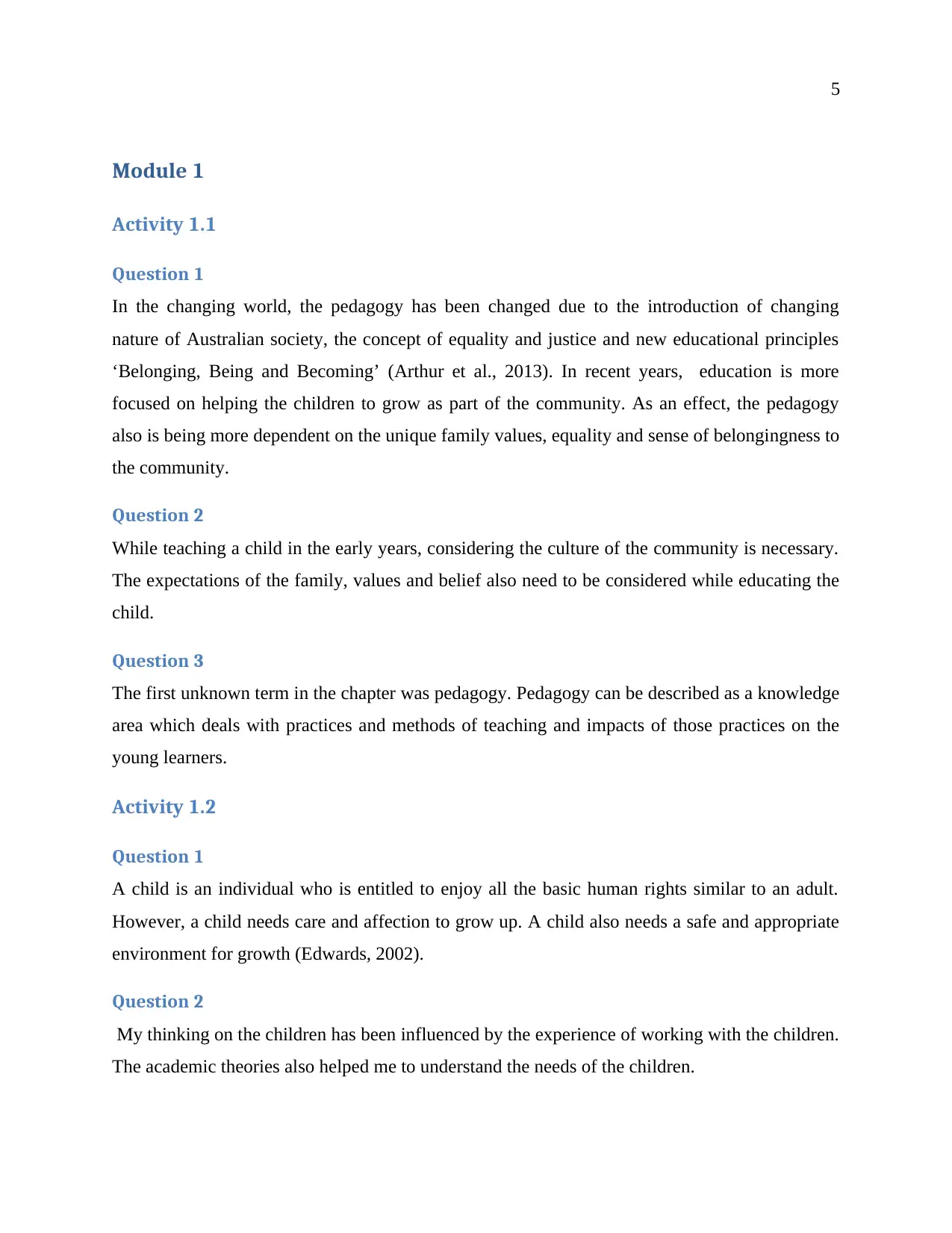
5
Module 1
Activity 1.1
Question 1
In the changing world, the pedagogy has been changed due to the introduction of changing
nature of Australian society, the concept of equality and justice and new educational principles
‘Belonging, Being and Becoming’ (Arthur et al., 2013). In recent years, education is more
focused on helping the children to grow as part of the community. As an effect, the pedagogy
also is being more dependent on the unique family values, equality and sense of belongingness to
the community.
Question 2
While teaching a child in the early years, considering the culture of the community is necessary.
The expectations of the family, values and belief also need to be considered while educating the
child.
Question 3
The first unknown term in the chapter was pedagogy. Pedagogy can be described as a knowledge
area which deals with practices and methods of teaching and impacts of those practices on the
young learners.
Activity 1.2
Question 1
A child is an individual who is entitled to enjoy all the basic human rights similar to an adult.
However, a child needs care and affection to grow up. A child also needs a safe and appropriate
environment for growth (Edwards, 2002).
Question 2
My thinking on the children has been influenced by the experience of working with the children.
The academic theories also helped me to understand the needs of the children.
Module 1
Activity 1.1
Question 1
In the changing world, the pedagogy has been changed due to the introduction of changing
nature of Australian society, the concept of equality and justice and new educational principles
‘Belonging, Being and Becoming’ (Arthur et al., 2013). In recent years, education is more
focused on helping the children to grow as part of the community. As an effect, the pedagogy
also is being more dependent on the unique family values, equality and sense of belongingness to
the community.
Question 2
While teaching a child in the early years, considering the culture of the community is necessary.
The expectations of the family, values and belief also need to be considered while educating the
child.
Question 3
The first unknown term in the chapter was pedagogy. Pedagogy can be described as a knowledge
area which deals with practices and methods of teaching and impacts of those practices on the
young learners.
Activity 1.2
Question 1
A child is an individual who is entitled to enjoy all the basic human rights similar to an adult.
However, a child needs care and affection to grow up. A child also needs a safe and appropriate
environment for growth (Edwards, 2002).
Question 2
My thinking on the children has been influenced by the experience of working with the children.
The academic theories also helped me to understand the needs of the children.
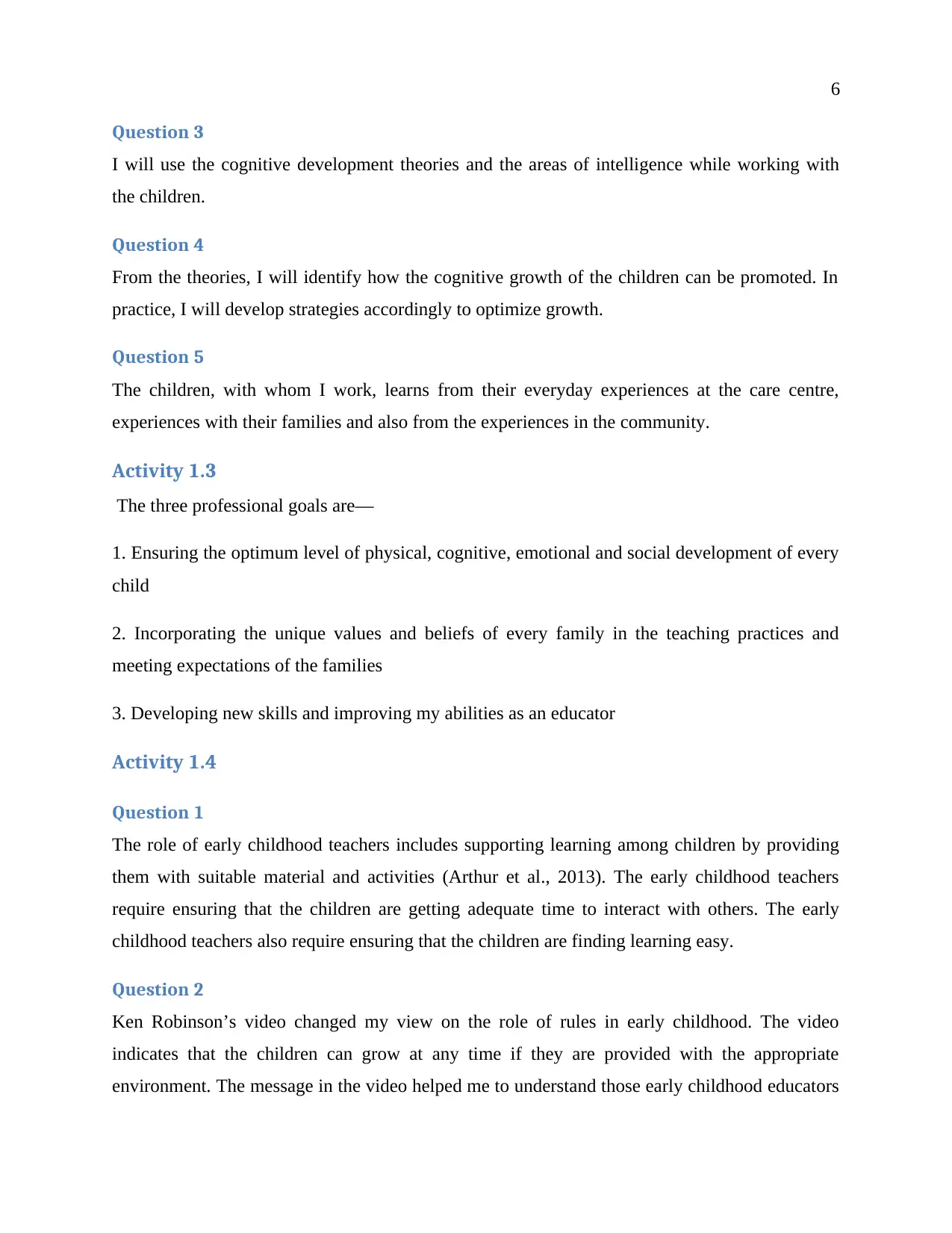
6
Question 3
I will use the cognitive development theories and the areas of intelligence while working with
the children.
Question 4
From the theories, I will identify how the cognitive growth of the children can be promoted. In
practice, I will develop strategies accordingly to optimize growth.
Question 5
The children, with whom I work, learns from their everyday experiences at the care centre,
experiences with their families and also from the experiences in the community.
Activity 1.3
The three professional goals are—
1. Ensuring the optimum level of physical, cognitive, emotional and social development of every
child
2. Incorporating the unique values and beliefs of every family in the teaching practices and
meeting expectations of the families
3. Developing new skills and improving my abilities as an educator
Activity 1.4
Question 1
The role of early childhood teachers includes supporting learning among children by providing
them with suitable material and activities (Arthur et al., 2013). The early childhood teachers
require ensuring that the children are getting adequate time to interact with others. The early
childhood teachers also require ensuring that the children are finding learning easy.
Question 2
Ken Robinson’s video changed my view on the role of rules in early childhood. The video
indicates that the children can grow at any time if they are provided with the appropriate
environment. The message in the video helped me to understand those early childhood educators
Question 3
I will use the cognitive development theories and the areas of intelligence while working with
the children.
Question 4
From the theories, I will identify how the cognitive growth of the children can be promoted. In
practice, I will develop strategies accordingly to optimize growth.
Question 5
The children, with whom I work, learns from their everyday experiences at the care centre,
experiences with their families and also from the experiences in the community.
Activity 1.3
The three professional goals are—
1. Ensuring the optimum level of physical, cognitive, emotional and social development of every
child
2. Incorporating the unique values and beliefs of every family in the teaching practices and
meeting expectations of the families
3. Developing new skills and improving my abilities as an educator
Activity 1.4
Question 1
The role of early childhood teachers includes supporting learning among children by providing
them with suitable material and activities (Arthur et al., 2013). The early childhood teachers
require ensuring that the children are getting adequate time to interact with others. The early
childhood teachers also require ensuring that the children are finding learning easy.
Question 2
Ken Robinson’s video changed my view on the role of rules in early childhood. The video
indicates that the children can grow at any time if they are provided with the appropriate
environment. The message in the video helped me to understand those early childhood educators
⊘ This is a preview!⊘
Do you want full access?
Subscribe today to unlock all pages.

Trusted by 1+ million students worldwide
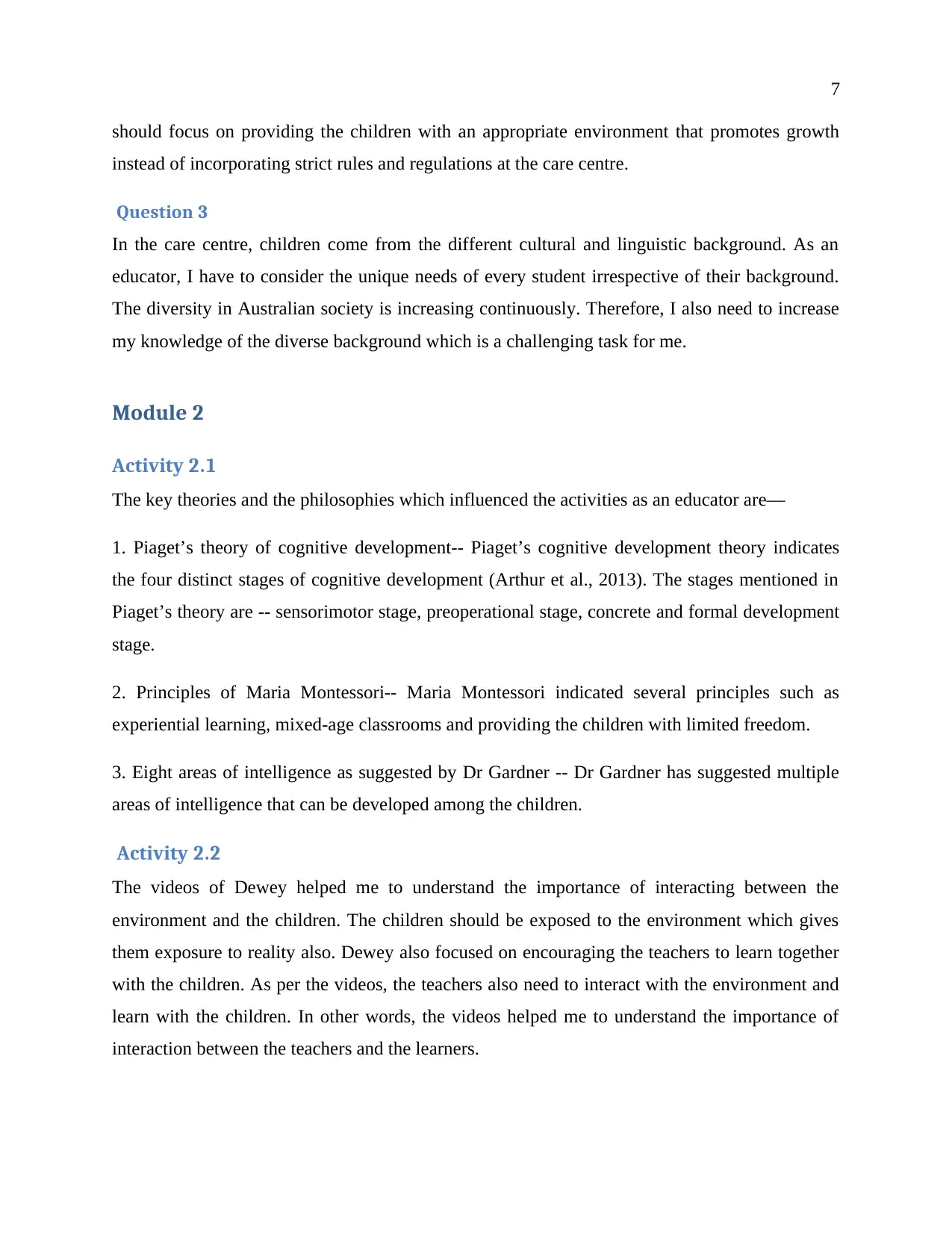
7
should focus on providing the children with an appropriate environment that promotes growth
instead of incorporating strict rules and regulations at the care centre.
Question 3
In the care centre, children come from the different cultural and linguistic background. As an
educator, I have to consider the unique needs of every student irrespective of their background.
The diversity in Australian society is increasing continuously. Therefore, I also need to increase
my knowledge of the diverse background which is a challenging task for me.
Module 2
Activity 2.1
The key theories and the philosophies which influenced the activities as an educator are—
1. Piaget’s theory of cognitive development-- Piaget’s cognitive development theory indicates
the four distinct stages of cognitive development (Arthur et al., 2013). The stages mentioned in
Piaget’s theory are -- sensorimotor stage, preoperational stage, concrete and formal development
stage.
2. Principles of Maria Montessori-- Maria Montessori indicated several principles such as
experiential learning, mixed-age classrooms and providing the children with limited freedom.
3. Eight areas of intelligence as suggested by Dr Gardner -- Dr Gardner has suggested multiple
areas of intelligence that can be developed among the children.
Activity 2.2
The videos of Dewey helped me to understand the importance of interacting between the
environment and the children. The children should be exposed to the environment which gives
them exposure to reality also. Dewey also focused on encouraging the teachers to learn together
with the children. As per the videos, the teachers also need to interact with the environment and
learn with the children. In other words, the videos helped me to understand the importance of
interaction between the teachers and the learners.
should focus on providing the children with an appropriate environment that promotes growth
instead of incorporating strict rules and regulations at the care centre.
Question 3
In the care centre, children come from the different cultural and linguistic background. As an
educator, I have to consider the unique needs of every student irrespective of their background.
The diversity in Australian society is increasing continuously. Therefore, I also need to increase
my knowledge of the diverse background which is a challenging task for me.
Module 2
Activity 2.1
The key theories and the philosophies which influenced the activities as an educator are—
1. Piaget’s theory of cognitive development-- Piaget’s cognitive development theory indicates
the four distinct stages of cognitive development (Arthur et al., 2013). The stages mentioned in
Piaget’s theory are -- sensorimotor stage, preoperational stage, concrete and formal development
stage.
2. Principles of Maria Montessori-- Maria Montessori indicated several principles such as
experiential learning, mixed-age classrooms and providing the children with limited freedom.
3. Eight areas of intelligence as suggested by Dr Gardner -- Dr Gardner has suggested multiple
areas of intelligence that can be developed among the children.
Activity 2.2
The videos of Dewey helped me to understand the importance of interacting between the
environment and the children. The children should be exposed to the environment which gives
them exposure to reality also. Dewey also focused on encouraging the teachers to learn together
with the children. As per the videos, the teachers also need to interact with the environment and
learn with the children. In other words, the videos helped me to understand the importance of
interaction between the teachers and the learners.
Paraphrase This Document
Need a fresh take? Get an instant paraphrase of this document with our AI Paraphraser
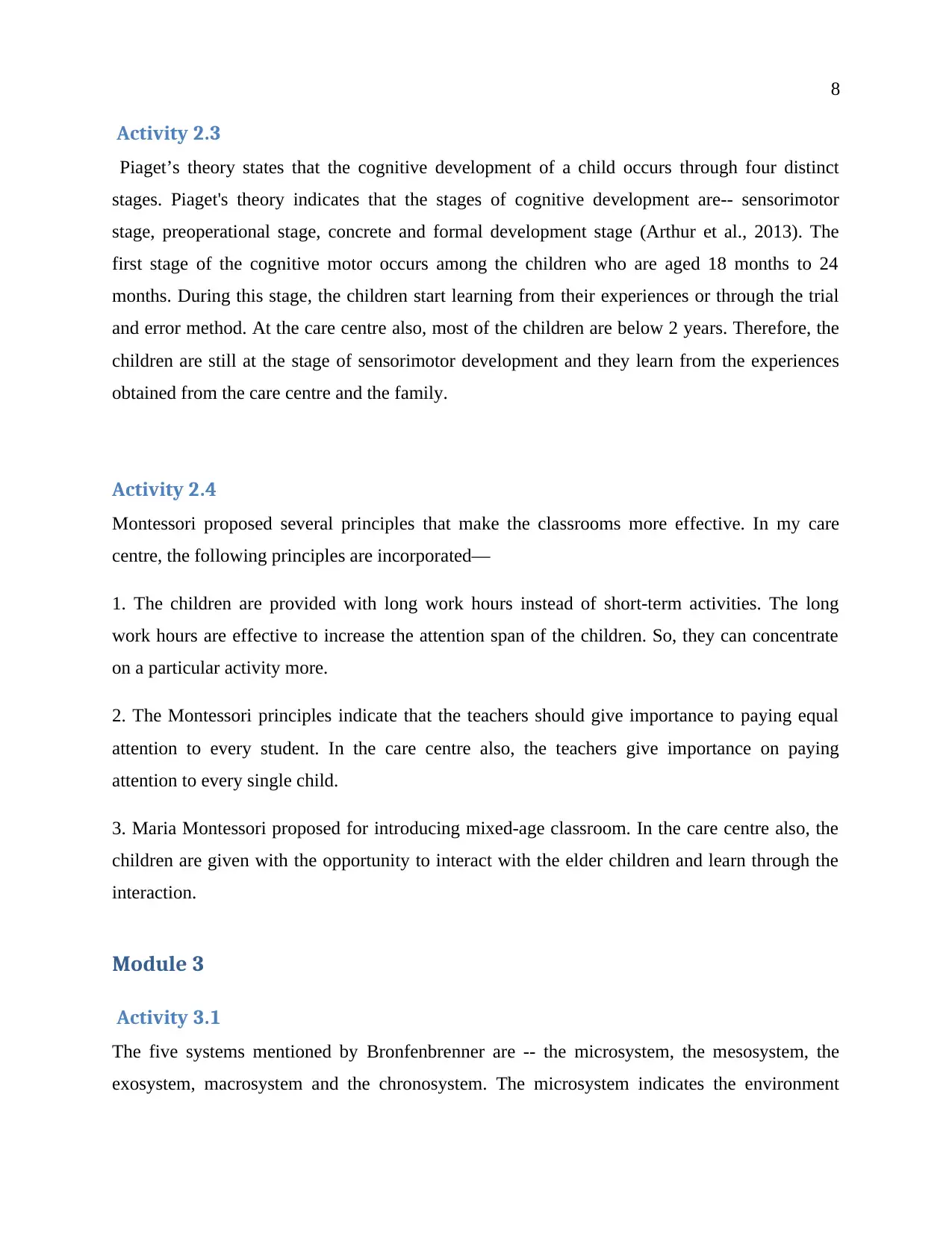
8
Activity 2.3
Piaget’s theory states that the cognitive development of a child occurs through four distinct
stages. Piaget's theory indicates that the stages of cognitive development are-- sensorimotor
stage, preoperational stage, concrete and formal development stage (Arthur et al., 2013). The
first stage of the cognitive motor occurs among the children who are aged 18 months to 24
months. During this stage, the children start learning from their experiences or through the trial
and error method. At the care centre also, most of the children are below 2 years. Therefore, the
children are still at the stage of sensorimotor development and they learn from the experiences
obtained from the care centre and the family.
Activity 2.4
Montessori proposed several principles that make the classrooms more effective. In my care
centre, the following principles are incorporated—
1. The children are provided with long work hours instead of short-term activities. The long
work hours are effective to increase the attention span of the children. So, they can concentrate
on a particular activity more.
2. The Montessori principles indicate that the teachers should give importance to paying equal
attention to every student. In the care centre also, the teachers give importance on paying
attention to every single child.
3. Maria Montessori proposed for introducing mixed-age classroom. In the care centre also, the
children are given with the opportunity to interact with the elder children and learn through the
interaction.
Module 3
Activity 3.1
The five systems mentioned by Bronfenbrenner are -- the microsystem, the mesosystem, the
exosystem, macrosystem and the chronosystem. The microsystem indicates the environment
Activity 2.3
Piaget’s theory states that the cognitive development of a child occurs through four distinct
stages. Piaget's theory indicates that the stages of cognitive development are-- sensorimotor
stage, preoperational stage, concrete and formal development stage (Arthur et al., 2013). The
first stage of the cognitive motor occurs among the children who are aged 18 months to 24
months. During this stage, the children start learning from their experiences or through the trial
and error method. At the care centre also, most of the children are below 2 years. Therefore, the
children are still at the stage of sensorimotor development and they learn from the experiences
obtained from the care centre and the family.
Activity 2.4
Montessori proposed several principles that make the classrooms more effective. In my care
centre, the following principles are incorporated—
1. The children are provided with long work hours instead of short-term activities. The long
work hours are effective to increase the attention span of the children. So, they can concentrate
on a particular activity more.
2. The Montessori principles indicate that the teachers should give importance to paying equal
attention to every student. In the care centre also, the teachers give importance on paying
attention to every single child.
3. Maria Montessori proposed for introducing mixed-age classroom. In the care centre also, the
children are given with the opportunity to interact with the elder children and learn through the
interaction.
Module 3
Activity 3.1
The five systems mentioned by Bronfenbrenner are -- the microsystem, the mesosystem, the
exosystem, macrosystem and the chronosystem. The microsystem indicates the environment
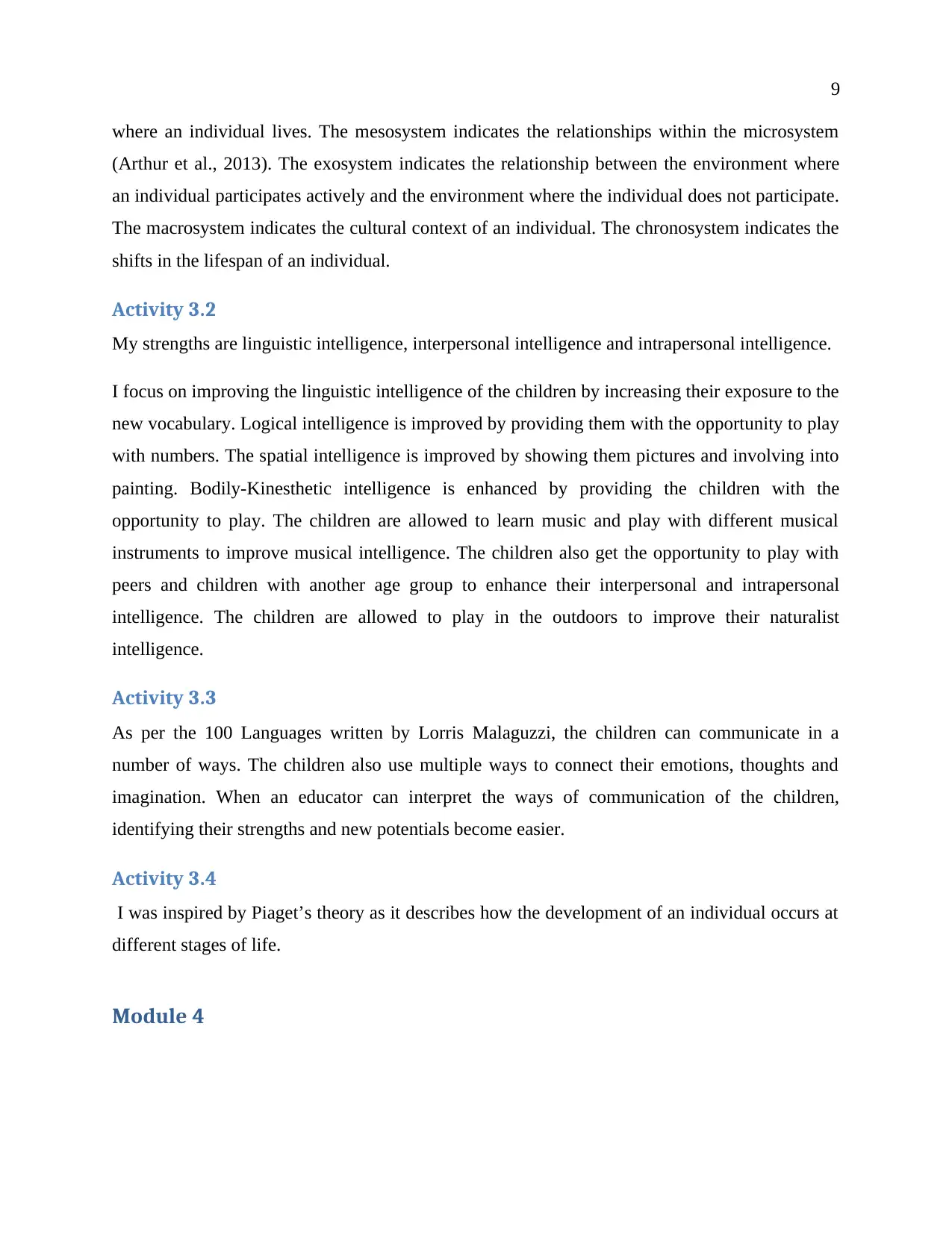
9
where an individual lives. The mesosystem indicates the relationships within the microsystem
(Arthur et al., 2013). The exosystem indicates the relationship between the environment where
an individual participates actively and the environment where the individual does not participate.
The macrosystem indicates the cultural context of an individual. The chronosystem indicates the
shifts in the lifespan of an individual.
Activity 3.2
My strengths are linguistic intelligence, interpersonal intelligence and intrapersonal intelligence.
I focus on improving the linguistic intelligence of the children by increasing their exposure to the
new vocabulary. Logical intelligence is improved by providing them with the opportunity to play
with numbers. The spatial intelligence is improved by showing them pictures and involving into
painting. Bodily-Kinesthetic intelligence is enhanced by providing the children with the
opportunity to play. The children are allowed to learn music and play with different musical
instruments to improve musical intelligence. The children also get the opportunity to play with
peers and children with another age group to enhance their interpersonal and intrapersonal
intelligence. The children are allowed to play in the outdoors to improve their naturalist
intelligence.
Activity 3.3
As per the 100 Languages written by Lorris Malaguzzi, the children can communicate in a
number of ways. The children also use multiple ways to connect their emotions, thoughts and
imagination. When an educator can interpret the ways of communication of the children,
identifying their strengths and new potentials become easier.
Activity 3.4
I was inspired by Piaget’s theory as it describes how the development of an individual occurs at
different stages of life.
Module 4
where an individual lives. The mesosystem indicates the relationships within the microsystem
(Arthur et al., 2013). The exosystem indicates the relationship between the environment where
an individual participates actively and the environment where the individual does not participate.
The macrosystem indicates the cultural context of an individual. The chronosystem indicates the
shifts in the lifespan of an individual.
Activity 3.2
My strengths are linguistic intelligence, interpersonal intelligence and intrapersonal intelligence.
I focus on improving the linguistic intelligence of the children by increasing their exposure to the
new vocabulary. Logical intelligence is improved by providing them with the opportunity to play
with numbers. The spatial intelligence is improved by showing them pictures and involving into
painting. Bodily-Kinesthetic intelligence is enhanced by providing the children with the
opportunity to play. The children are allowed to learn music and play with different musical
instruments to improve musical intelligence. The children also get the opportunity to play with
peers and children with another age group to enhance their interpersonal and intrapersonal
intelligence. The children are allowed to play in the outdoors to improve their naturalist
intelligence.
Activity 3.3
As per the 100 Languages written by Lorris Malaguzzi, the children can communicate in a
number of ways. The children also use multiple ways to connect their emotions, thoughts and
imagination. When an educator can interpret the ways of communication of the children,
identifying their strengths and new potentials become easier.
Activity 3.4
I was inspired by Piaget’s theory as it describes how the development of an individual occurs at
different stages of life.
Module 4
⊘ This is a preview!⊘
Do you want full access?
Subscribe today to unlock all pages.

Trusted by 1+ million students worldwide
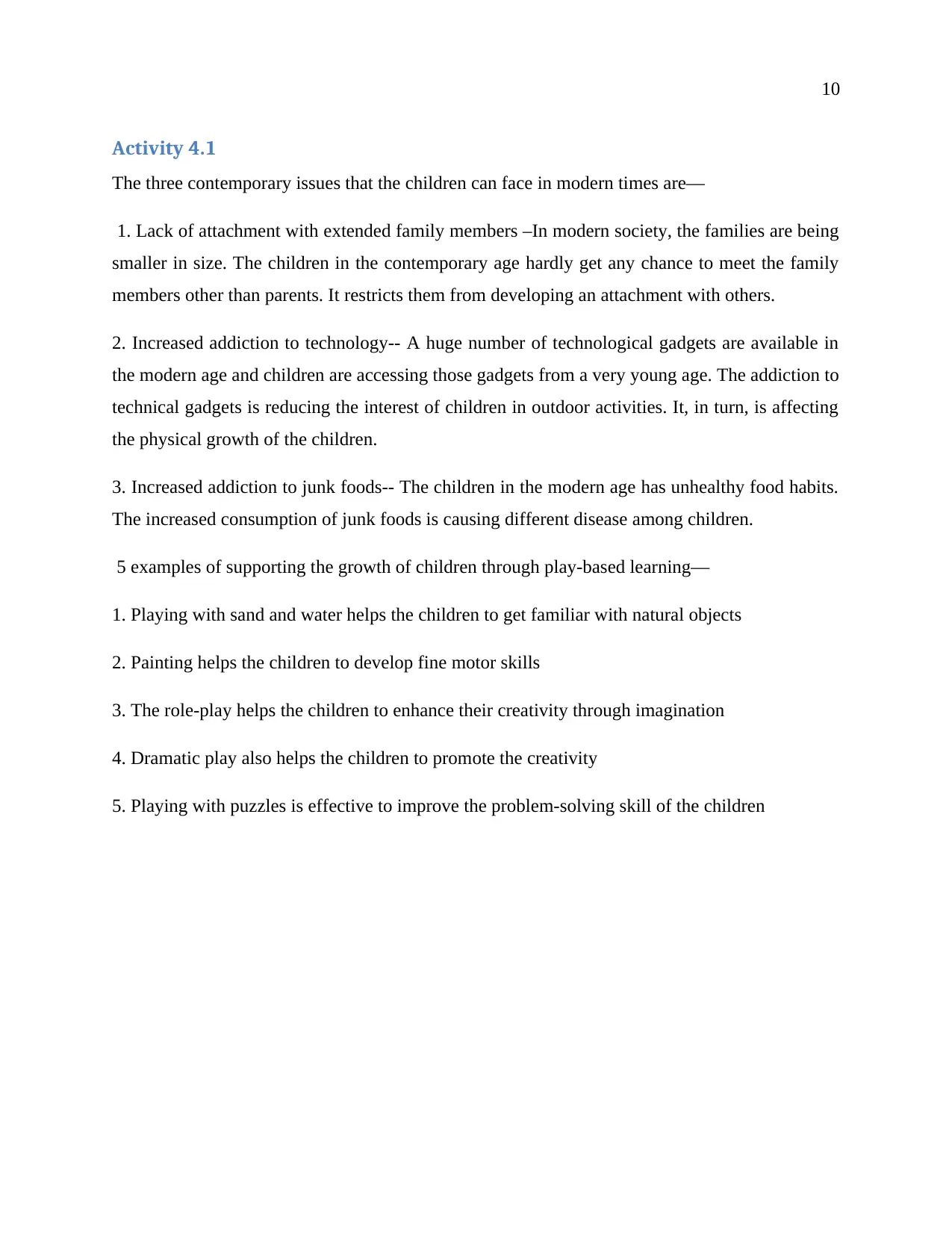
10
Activity 4.1
The three contemporary issues that the children can face in modern times are—
1. Lack of attachment with extended family members –In modern society, the families are being
smaller in size. The children in the contemporary age hardly get any chance to meet the family
members other than parents. It restricts them from developing an attachment with others.
2. Increased addiction to technology-- A huge number of technological gadgets are available in
the modern age and children are accessing those gadgets from a very young age. The addiction to
technical gadgets is reducing the interest of children in outdoor activities. It, in turn, is affecting
the physical growth of the children.
3. Increased addiction to junk foods-- The children in the modern age has unhealthy food habits.
The increased consumption of junk foods is causing different disease among children.
5 examples of supporting the growth of children through play-based learning—
1. Playing with sand and water helps the children to get familiar with natural objects
2. Painting helps the children to develop fine motor skills
3. The role-play helps the children to enhance their creativity through imagination
4. Dramatic play also helps the children to promote the creativity
5. Playing with puzzles is effective to improve the problem-solving skill of the children
Activity 4.1
The three contemporary issues that the children can face in modern times are—
1. Lack of attachment with extended family members –In modern society, the families are being
smaller in size. The children in the contemporary age hardly get any chance to meet the family
members other than parents. It restricts them from developing an attachment with others.
2. Increased addiction to technology-- A huge number of technological gadgets are available in
the modern age and children are accessing those gadgets from a very young age. The addiction to
technical gadgets is reducing the interest of children in outdoor activities. It, in turn, is affecting
the physical growth of the children.
3. Increased addiction to junk foods-- The children in the modern age has unhealthy food habits.
The increased consumption of junk foods is causing different disease among children.
5 examples of supporting the growth of children through play-based learning—
1. Playing with sand and water helps the children to get familiar with natural objects
2. Painting helps the children to develop fine motor skills
3. The role-play helps the children to enhance their creativity through imagination
4. Dramatic play also helps the children to promote the creativity
5. Playing with puzzles is effective to improve the problem-solving skill of the children
Paraphrase This Document
Need a fresh take? Get an instant paraphrase of this document with our AI Paraphraser
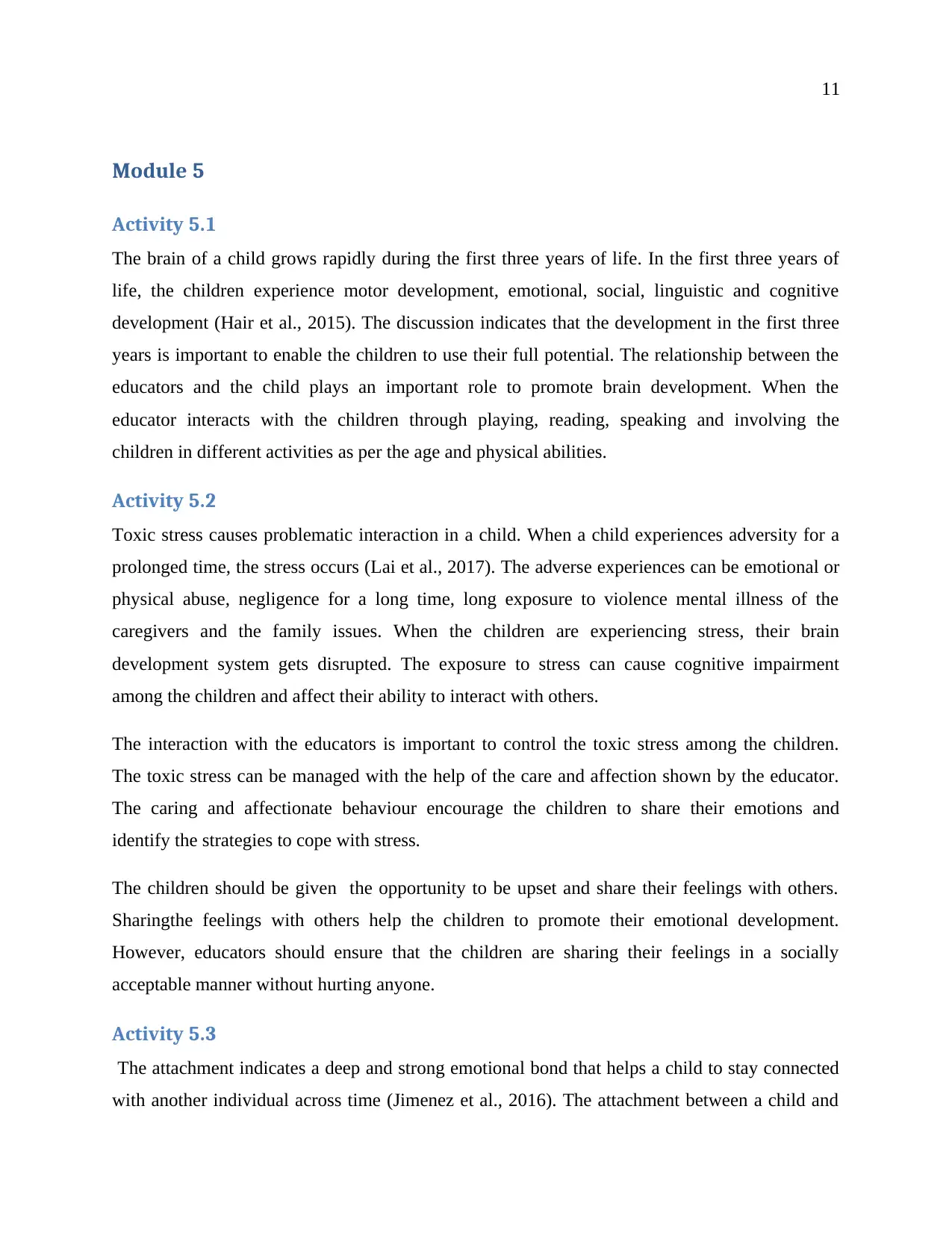
11
Module 5
Activity 5.1
The brain of a child grows rapidly during the first three years of life. In the first three years of
life, the children experience motor development, emotional, social, linguistic and cognitive
development (Hair et al., 2015). The discussion indicates that the development in the first three
years is important to enable the children to use their full potential. The relationship between the
educators and the child plays an important role to promote brain development. When the
educator interacts with the children through playing, reading, speaking and involving the
children in different activities as per the age and physical abilities.
Activity 5.2
Toxic stress causes problematic interaction in a child. When a child experiences adversity for a
prolonged time, the stress occurs (Lai et al., 2017). The adverse experiences can be emotional or
physical abuse, negligence for a long time, long exposure to violence mental illness of the
caregivers and the family issues. When the children are experiencing stress, their brain
development system gets disrupted. The exposure to stress can cause cognitive impairment
among the children and affect their ability to interact with others.
The interaction with the educators is important to control the toxic stress among the children.
The toxic stress can be managed with the help of the care and affection shown by the educator.
The caring and affectionate behaviour encourage the children to share their emotions and
identify the strategies to cope with stress.
The children should be given the opportunity to be upset and share their feelings with others.
Sharingthe feelings with others help the children to promote their emotional development.
However, educators should ensure that the children are sharing their feelings in a socially
acceptable manner without hurting anyone.
Activity 5.3
The attachment indicates a deep and strong emotional bond that helps a child to stay connected
with another individual across time (Jimenez et al., 2016). The attachment between a child and
Module 5
Activity 5.1
The brain of a child grows rapidly during the first three years of life. In the first three years of
life, the children experience motor development, emotional, social, linguistic and cognitive
development (Hair et al., 2015). The discussion indicates that the development in the first three
years is important to enable the children to use their full potential. The relationship between the
educators and the child plays an important role to promote brain development. When the
educator interacts with the children through playing, reading, speaking and involving the
children in different activities as per the age and physical abilities.
Activity 5.2
Toxic stress causes problematic interaction in a child. When a child experiences adversity for a
prolonged time, the stress occurs (Lai et al., 2017). The adverse experiences can be emotional or
physical abuse, negligence for a long time, long exposure to violence mental illness of the
caregivers and the family issues. When the children are experiencing stress, their brain
development system gets disrupted. The exposure to stress can cause cognitive impairment
among the children and affect their ability to interact with others.
The interaction with the educators is important to control the toxic stress among the children.
The toxic stress can be managed with the help of the care and affection shown by the educator.
The caring and affectionate behaviour encourage the children to share their emotions and
identify the strategies to cope with stress.
The children should be given the opportunity to be upset and share their feelings with others.
Sharingthe feelings with others help the children to promote their emotional development.
However, educators should ensure that the children are sharing their feelings in a socially
acceptable manner without hurting anyone.
Activity 5.3
The attachment indicates a deep and strong emotional bond that helps a child to stay connected
with another individual across time (Jimenez et al., 2016). The attachment between a child and
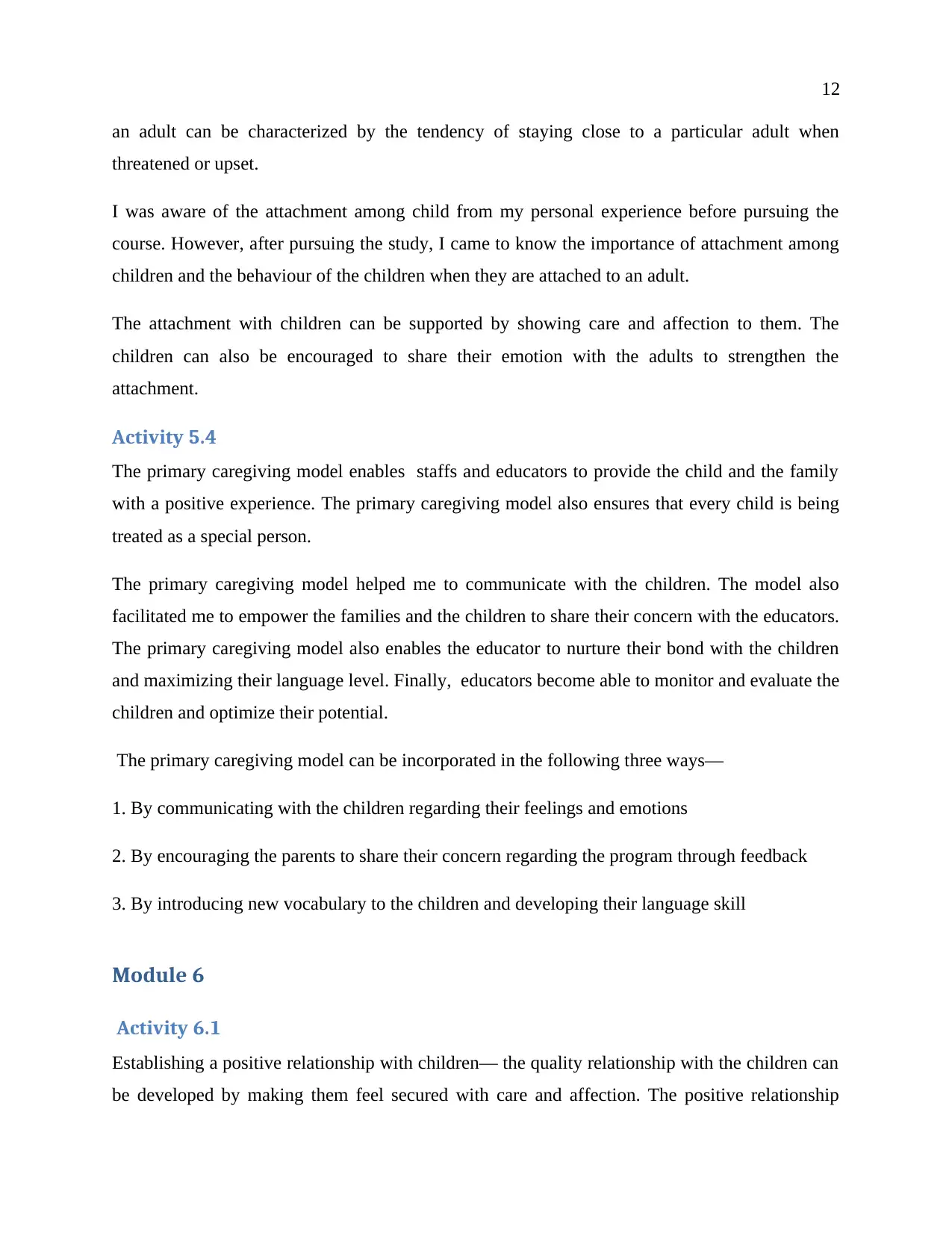
12
an adult can be characterized by the tendency of staying close to a particular adult when
threatened or upset.
I was aware of the attachment among child from my personal experience before pursuing the
course. However, after pursuing the study, I came to know the importance of attachment among
children and the behaviour of the children when they are attached to an adult.
The attachment with children can be supported by showing care and affection to them. The
children can also be encouraged to share their emotion with the adults to strengthen the
attachment.
Activity 5.4
The primary caregiving model enables staffs and educators to provide the child and the family
with a positive experience. The primary caregiving model also ensures that every child is being
treated as a special person.
The primary caregiving model helped me to communicate with the children. The model also
facilitated me to empower the families and the children to share their concern with the educators.
The primary caregiving model also enables the educator to nurture their bond with the children
and maximizing their language level. Finally, educators become able to monitor and evaluate the
children and optimize their potential.
The primary caregiving model can be incorporated in the following three ways—
1. By communicating with the children regarding their feelings and emotions
2. By encouraging the parents to share their concern regarding the program through feedback
3. By introducing new vocabulary to the children and developing their language skill
Module 6
Activity 6.1
Establishing a positive relationship with children— the quality relationship with the children can
be developed by making them feel secured with care and affection. The positive relationship
an adult can be characterized by the tendency of staying close to a particular adult when
threatened or upset.
I was aware of the attachment among child from my personal experience before pursuing the
course. However, after pursuing the study, I came to know the importance of attachment among
children and the behaviour of the children when they are attached to an adult.
The attachment with children can be supported by showing care and affection to them. The
children can also be encouraged to share their emotion with the adults to strengthen the
attachment.
Activity 5.4
The primary caregiving model enables staffs and educators to provide the child and the family
with a positive experience. The primary caregiving model also ensures that every child is being
treated as a special person.
The primary caregiving model helped me to communicate with the children. The model also
facilitated me to empower the families and the children to share their concern with the educators.
The primary caregiving model also enables the educator to nurture their bond with the children
and maximizing their language level. Finally, educators become able to monitor and evaluate the
children and optimize their potential.
The primary caregiving model can be incorporated in the following three ways—
1. By communicating with the children regarding their feelings and emotions
2. By encouraging the parents to share their concern regarding the program through feedback
3. By introducing new vocabulary to the children and developing their language skill
Module 6
Activity 6.1
Establishing a positive relationship with children— the quality relationship with the children can
be developed by making them feel secured with care and affection. The positive relationship
⊘ This is a preview!⊘
Do you want full access?
Subscribe today to unlock all pages.

Trusted by 1+ million students worldwide
1 out of 18
Related Documents
Your All-in-One AI-Powered Toolkit for Academic Success.
+13062052269
info@desklib.com
Available 24*7 on WhatsApp / Email
![[object Object]](/_next/static/media/star-bottom.7253800d.svg)
Unlock your academic potential
Copyright © 2020–2025 A2Z Services. All Rights Reserved. Developed and managed by ZUCOL.





